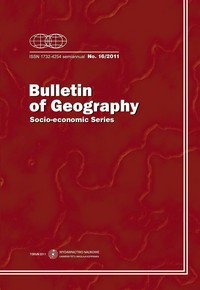Analysis of Leading Cities in Central Europe: Control of Regional Economy
DOI:
https://doi.org/10.1515/v10089-011-0012-yKeywords
Central Europe, Visegrád Group, city rank, world cities, economic control, transnational corporations, stock exchangeAbstract
Nowadays, one of the characteristic orientations in social science studies focusing on cities is the ranking of cities, as well as the definition of the world's leading cities (world cities, global cities) on the basis of various criteria. Central European countries are given just a minor role in these researches, particularly in comparison with German cities with their considerable economic performance. This analysis compares the large cities of Austria, Germany and the countries of the Visegrád Group in terms of their role in economic leadership. To this end, the characteristic parameters have been examined: the GDP in purchasing power standards and nominal GDP of the cities, the revenues of large companies found in these cities, as well as the domestic market capitalization of the stock exchanges.References
Beaverstock, J.V., Taylor, P.J. and Smith, R.G. 1999: A roster of world cities. In: Cities, 16, 6, pp. 445-458.
http://dx.doi.org/10.1016/S0264-2751(99)00042-6
Friedmann, J. 1995: Where we stand: a decade of world city research. In: Knox, P.L. and Taylor, P.J. editors, World cities in a world-system, Cambridge: Cambridge University Press, pp. 21-47.
http://dx.doi.org/10.1017/CBO9780511522192.003
Geddes, P. 1915: Cities in Evolution, London: Benn.
Hall, P. 1966: The World Cities, London: Heinemann.
Heenan, D.A. 1977: Global cities of tomorrow. In: Harvard Business Review, 55 (May/June), pp. 79-92.
Hymer, S. 1972: The multinational corporation and the law of uneven development. In: Bhagwati, J. editor, Economics and World Order from the 1970s to the 1990s, New York: Collier-MacMillan, pp. 113-140.
Ivanička, K. Sr. and Ivanička, K. Jr. 2007: Regional growth dynamics in Central and Eastern Europe in the socio-economic and geographic context of a post-socialist reality. In: Stanilov, K. editor, The Post-Socialist City: Urban Form and Space Transformations in Central and Eastern Europe after Socialism, Dordrecht: Springer, pp. 35-52.
Mulligan, G.F. and Crampton, J.P. 2005: Population growth in the world's largest cities. In: Cities, 22, 5, pp. 365-380.
http://dx.doi.org/10.1016/j.cities.2005.07.001
Musil, R. 2009: Global capital control and city hierarchies: an attempt to reposition Vienna in a world city network. In: Cities, 26, 5, pp. 255-265.
http://dx.doi.org/10.1016/j.cities.2009.07.002
PwhC - PricewaterhouseCoopers (2009) UK Economic Outlook, November 2009 http://www.pwc.com/im/en/assets/document/UK_Economic_Outlook_Nov_09.pdf
Sassen, S. 1991: The Global City: New York, London, Tokyo, Princeton: Princeton University Press.
Sassen, S. 1995: On concentration and centrality in the global city. In: Knox, P.L. and Taylor, P.J. editors, World cities in a world-system, Cambridge: Cambridge University Press, pp. 63-78.
http://dx.doi.org/10.1017/CBO9780511522192.005
Sassen, S. 2006: Cities in a world economy (Third edition), Pine Forge Press, Thousand Oaks.
Smith, D. and Timberlake, M. 2002: Hierarchies of Dominance among World Cities: A Network Approach. In: Sassen, S. editor, Global Networks, Linked Cities, New York-London: Routledge, pp. 117-144.
Szymańska, D. 2007: Urbanizacja na świecie, Warszawa: Wydawnictwo Naukowe PWN, p. 390.
Taylor, P.J. 2004: World City Network: A Global Urban Analysis, New York-London: Routledge.
Taylor, P.J., Walker, D.R.F., Catalno, G. and Hoyler, M. 2002: Diversity and power in the world city network. In: Cities, 19, 4, pp. 231-241.
http://dx.doi.org/10.1016/S0264-2751(02)00020-3
Turok, I. and Mykhnenko, V. 2007: The trajectories of European cities, 1960-2005. In: Cities, 24, 3, pp. 165-182.
http://dx.doi.org/10.1016/j.cities.2007.01.007
UN - United Nations, 2008: World Urbanization Prospects, The 2007 Revision, New York: United Nations.
Downloads
Published
How to Cite
Issue
Section
License
Title, logo and layout of journal Bulletin of Geography. Socio-economic Series are reserved trademarks of Bulletin of Geography. Socio-economic Series.Stats
Number of views and downloads: 595
Number of citations: 0



